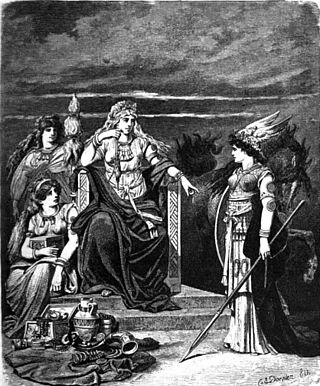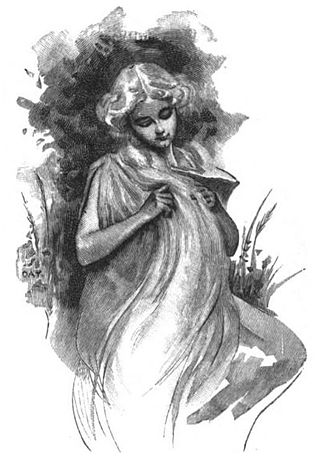
In Norse mythology, Hringhorni (Old Norse "ship with a circle on the stem" [1] ) is the name of the ship of the god Baldr, described as the "greatest of all ships".

In Norse mythology, Hringhorni (Old Norse "ship with a circle on the stem" [1] ) is the name of the ship of the god Baldr, described as the "greatest of all ships".
According to Gylfaginning , following the murder of Baldr by Loki, the other gods brought his body down to the sea and laid him to rest on the ship. They would have launched it out into the water and kindled a funeral pyre for Baldr but were unable to move the great vessel without the help of the giantess Hyrrokkin, who was sent for out of Jötunheim. She then flung the ship so violently down the rollers at the first push that flames appeared and the earth trembled, much to the annoyance of Thor.
Along with Baldr, his wife Nanna was also borne to the funeral pyre after she had died of grief. As Thor was consecrating the fire with his hammer Mjolnir, a dwarf named Litr began cavorting at his feet. Thor then kicked him into the flames and the dwarf was burned up as well. The significance of this seemingly incidental event is speculative but may perhaps find a parallel in religious ritual. Among other artifacts and creatures sacrificed on the pyre of Hringhorni were Odin's gold ring Draupnir and the horse of Baldr with all its trappings.

In Nordic mythology, Asgard is a location associated with the gods. It appears in a multitude of Old Norse sagas and mythological texts. It is described as the fortified home of the Æsir gods, often associated with gold imagery. Many of the best-known Nordic gods are Æsir or live in Asgard such as Odin, Thor, Loki, and Baldr.

Baldr is a god in Germanic mythology. In Norse mythology, he is a son of the god Odin and the goddess Frigg, and has numerous brothers, such as Thor and Váli. In wider Germanic mythology, the god was known in Old English as Bældæġ, and in Old High German as Balder, all ultimately stemming from the Proto-Germanic theonym *Balðraz.

In Norse mythology, Freyja is a goddess associated with love, beauty, fertility, sex, war, gold, and seiðr. Freyja is the owner of the necklace Brísingamen, rides a chariot pulled by two cats, is accompanied by the boar Hildisvíni, and possesses a cloak of falcon feathers. By her husband Óðr, she is the mother of two daughters, Hnoss and Gersemi. Along with her twin brother Freyr, her father Njörðr, and her mother, she is a member of the Vanir. Stemming from Old Norse Freyja, modern forms of the name include Freya, Freyia, and Freja.

Frigg is a goddess, one of the Æsir, in Germanic mythology. In Norse mythology, the source of most surviving information about her, she is associated with marriage, prophecy, clairvoyance and motherhood, and dwells in the wetland halls of Fensalir. In wider Germanic mythology, she is known in Old High German as Frīja, in Langobardic as Frēa, in Old English as Frīg, in Old Frisian as Frīa, and in Old Saxon as Frī, all ultimately stemming from the Proto-Germanic theonym *Frijjō. Nearly all sources portray her as the wife of the god Odin.

In Norse mythology, Heimdall is a god. He is the son of Odin and nine mothers. Heimdall keeps watch for invaders and the onset of Ragnarök from his dwelling Himinbjörg, where the burning rainbow bridge Bifröst meets the sky. He is attested as possessing foreknowledge and keen senses, particularly eyesight and hearing. The god and his possessions are described in enigmatic manners. For example, Heimdall is emerald-toothed, "the head is called his sword," and he is "the whitest of the gods."

Loki is a god in Norse mythology. Loki is the son of Fárbauti and Laufey, and the brother of Helblindi and Býleistr. Loki is married to Sigyn and they have two sons, Narfi or Nari and Váli. By the jötunn Angrboða, Loki is the father of Hel, the wolf Fenrir, and the world serpent Jörmungandr. In the form of a mare, Loki was impregnated by the stallion Svaðilfari and gave birth to the eight-legged horse Sleipnir.

In Norse mythology, Ragnarök is a foretold series of impending events, including a great battle in which numerous great Norse mythological figures will perish ; it will entail a catastrophic series of natural disasters, including the burning of the world, and culminate in the submersion of the world underwater. After these events, the world will rise again, cleansed and fertile, the surviving and returning gods will meet, and the world will be repopulated by two human survivors, Líf and Lífþrasir. Ragnarök is an important event in Norse mythology and has been the subject of scholarly discourse and theory in the history of Germanic studies.

In Norse mythology, Sleipnir is an eight-legged horse ridden by Odin. Sleipnir is attested in the Poetic Edda, compiled in the 13th century from earlier traditional sources, and the Prose Edda, written in the 13th century by Snorri Sturluson. In both sources, Sleipnir is Odin's steed, is the child of Loki and Svaðilfari, is described as the best of all horses, and is sometimes ridden to the location of Hel. The Prose Edda contains extended information regarding the circumstances of Sleipnir's birth, and details that he is grey in color.

In Norse mythology Valhalla is the anglicised name for Old Norse: Valhǫll. It is described as a majestic hall located in Asgard and presided over by the god Odin. Half of those who die in combat enter Valhalla, while the other half are chosen by the goddess Freyja to reside in Fólkvangr. The masses of those killed in combat along with various legendary Germanic heroes and kings, live in Valhalla until Ragnarök when they will march out of its many doors to fight in aid of Odin against the jötnar.

In Norse mythology, Sif is a golden-haired goddess associated with earth. Sif is attested in the Poetic Edda, compiled in the 13th century from earlier traditional sources, and the Prose Edda, written in the 13th century by Snorri Sturluson, and in the poetry of skalds. In both the Poetic Edda and the Prose Edda, she is known for her golden hair and is married to the thunder god Thor.

Mjölnir is the hammer of the thunder god Thor in Norse mythology, used both as a devastating weapon and as a divine instrument to provide blessings. The hammer is attested in numerous sources, including the 11th century runic Kvinneby amulet, the Poetic Edda, a collection of eddic poetry compiled in the 13th century, and the Prose Edda, a collection of prose and poetry compiled in the 13th century. The hammer was commonly worn as a pendant during the Viking Age in the Scandinavian cultural sphere, and Thor and his hammer occur depicted on a variety of objects from the archaeological record. Today the symbol appears in a wide variety of media and is again worn as a pendant by various groups, including adherents of modern Heathenry.

Thor is a prominent god in Germanic paganism. In Norse mythology, he is a hammer-wielding god associated with lightning, thunder, storms, sacred groves and trees, strength, the protection of humankind, hallowing, and fertility. Besides Old Norse Þórr, the deity occurs in Old English as Þunor ("Thunor"), in Old Frisian as Thuner, in Old Saxon as Thunar, and in Old High German as Donar, all ultimately stemming from the Proto-Germanic theonym *Þun(a)raz, meaning 'Thunder'.
In Norse mythology, Meili is a god, son of the god Odin and Jörð, and brother of the god Thor. Meili is attested in the Poetic Edda, compiled in the 13th century from earlier traditional sources, and the Prose Edda, written in the 13th century by Snorri Sturluson. Other than Meili's relation to Odin and Thor, no additional information is provided about the deity in either source.
In Norse mythology, Nanna Nepsdóttir or simply Nanna is a goddess associated with the god Baldr. Accounts of Nanna vary greatly by source. In the Prose Edda, written in the 13th century by Snorri Sturluson, Nanna is married to Baldr and the couple produced a son, the god Forseti.

Hyrrokkin is a female jötunn in Norse mythology. According to 13th-century poet Snorri Sturluson, she launched the largest of all ships at Baldr's funeral after the Æsir gods were unable to budge the vessel.
In Norse mythology, Sindri is the name of both a dwarf and a hall that will serve as a dwelling place for the souls of the virtuous after the events of Ragnarök. Sindri is also referred to as Eitri, the brother of Brokkr.

Litr is the name borne by a dwarf and a jötunn in Norse mythology.
In Norse mythology, Móðguðr refers to the female guardian of the bridge over the river Gjöll ("Noisy"), Gjallarbrú. She allowed the newly dead to use the bridge to cross from one side of the river Gjöll to the other if the soul stated their name and business, and possibly in turn prevented the dead beyond the river from crossing back over Gjöll into the lands of the living.

Death in Norse paganism was associated with diverse customs and beliefs that varied with time, location and social group, and did not form a structured, uniform system. After the funeral, the individual could go to a range of afterlives including Valhalla, Hel and living on physically in the landscape. These afterlives show blurred boundaries and exist alongside a number of minor afterlives that may have been significant in Nordic paganism. The dead were also seen as being able to bestow land fertility, often in return for votive offerings, and knowledge, either willingly or after coercion. Many of these beliefs and practices continued in altered forms after the Christianisation of the Germanic peoples in folk belief.

Norse, Nordic, or Scandinavian mythology, is the body of myths belonging to the North Germanic peoples, stemming from Old Norse religion and continuing after the Christianization of Scandinavia, and into the Nordic folklore of the modern period. The northernmost extension of Germanic mythology and stemming from Proto-Germanic folklore, Norse mythology consists of tales of various deities, beings, and heroes derived from numerous sources from both before and after the pagan period, including medieval manuscripts, archaeological representations, and folk tradition. The source texts mention numerous gods such as the thunder-god Thor, the raven-flanked god Odin, the goddess Freyja, and numerous other deities.